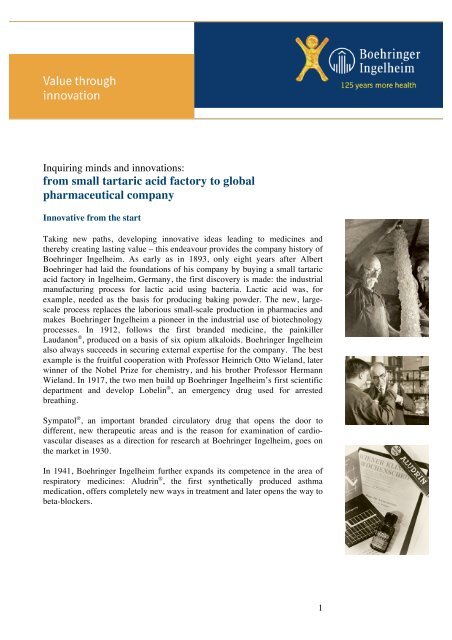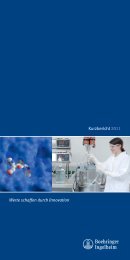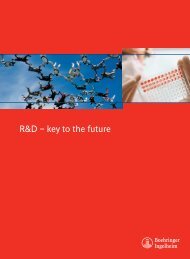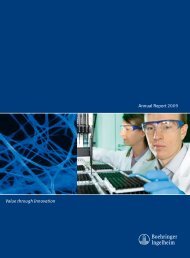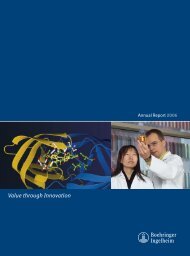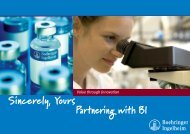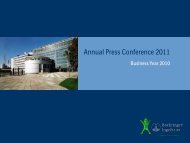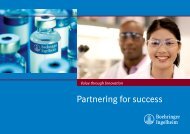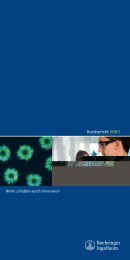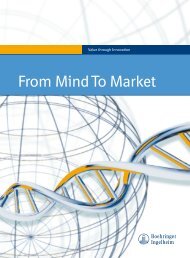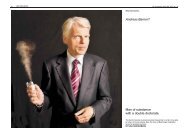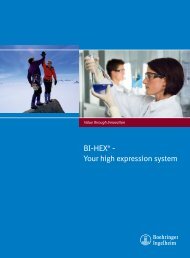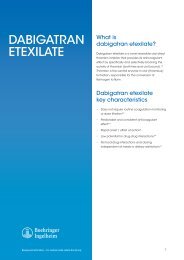from small tartaric acid factory to global ... - Boehringer Ingelheim
from small tartaric acid factory to global ... - Boehringer Ingelheim
from small tartaric acid factory to global ... - Boehringer Ingelheim
Create successful ePaper yourself
Turn your PDF publications into a flip-book with our unique Google optimized e-Paper software.
Inquiring minds and innovations:<br />
<strong>from</strong> <strong>small</strong> <strong>tartaric</strong> <strong>acid</strong> <strong>fac<strong>to</strong>ry</strong> <strong>to</strong> <strong>global</strong><br />
pharmaceutical company<br />
Innovative <strong>from</strong> the start<br />
Taking new paths, developing innovative ideas leading <strong>to</strong> medicines and<br />
thereby creating lasting value – this endeavour provides the company his<strong>to</strong>ry of<br />
<strong>Boehringer</strong> <strong>Ingelheim</strong>. As early as in 1893, only eight years after Albert<br />
<strong>Boehringer</strong> had laid the foundations of his company by buying a <strong>small</strong> <strong>tartaric</strong><br />
<strong>acid</strong> <strong>fac<strong>to</strong>ry</strong> in <strong>Ingelheim</strong>, Germany, the first discovery is made: the industrial<br />
manufacturing process for lactic <strong>acid</strong> using bacteria. Lactic <strong>acid</strong> was, for<br />
example, needed as the basis for producing baking powder. The new, largescale<br />
process replaces the laborious <strong>small</strong>-scale production in pharmacies and<br />
makes <strong>Boehringer</strong> <strong>Ingelheim</strong> a pioneer in the industrial use of biotechnology<br />
processes. In 1912, follows the first branded medicine, the painkiller<br />
Laudanon ® , produced on a basis of six opium alkaloids. <strong>Boehringer</strong> <strong>Ingelheim</strong><br />
also always succeeds in securing external expertise for the company. The best<br />
example is the fruitful cooperation with Professor Heinrich Ot<strong>to</strong> Wieland, later<br />
winner of the Nobel Prize for chemistry, and his brother Professor Hermann<br />
Wieland. In 1917, the two men build up <strong>Boehringer</strong> <strong>Ingelheim</strong>’s first scientific<br />
department and develop Lobelin ® , an emergency drug used for arrested<br />
breathing.<br />
Sympa<strong>to</strong>l ® , an important branded circula<strong>to</strong>ry drug that opens the door <strong>to</strong><br />
different, new therapeutic areas and is the reason for examination of cardiovascular<br />
diseases as a direction for research at <strong>Boehringer</strong> <strong>Ingelheim</strong>, goes on<br />
the market in 1930.<br />
In 1941, <strong>Boehringer</strong> <strong>Ingelheim</strong> further expands its competence in the area of<br />
respira<strong>to</strong>ry medicines: Aludrin ® , the first synthetically produced asthma<br />
medication, offers completely new ways in treatment and later opens the way <strong>to</strong><br />
beta-blockers.<br />
1
The analgesic Thomapyrin ® is a Consumer Health Care classic that has been<br />
produced and marketed <strong>from</strong> the Swabian site Biberach an der Riss since 1946.<br />
The company Dr. Karl Thomä & Cie. <strong>from</strong> Winnenden near Stuttgart, acquired<br />
by Albert <strong>Boehringer</strong> back in 1928, is in the same year relocated <strong>to</strong> Biberach<br />
under the slightly altered name of Dr. Karl Thomae GmbH.<br />
<strong>Boehringer</strong> <strong>Ingelheim</strong> “conquers the world“:<br />
internationalisation and indication area expansion<br />
In the 1940s, international markets gain increasing importance for the<br />
chemical-pharmaceutical industry. <strong>Boehringer</strong> <strong>Ingelheim</strong> responds <strong>to</strong> this by<br />
establishing companies outside Germany, setting up the first one in Vienna,<br />
Austria, in 1948. More follow in Europe and overseas. The internationalisation<br />
of sales of medications <strong>from</strong> the company’s own research and development<br />
leads <strong>to</strong> markedly increased turnover: in 1950, earnings <strong>from</strong> business outside<br />
Germany amount <strong>to</strong> 11.6 million German marks; in 1986, they already <strong>to</strong>tal 3.3<br />
billion German marks of which more than 80 percent comes <strong>from</strong> abroad. In<br />
2009, <strong>Boehringer</strong> <strong>Ingelheim</strong> achieves net sales of more than EUR 11.3 billion<br />
with prescription medicines, of which less than six percent come <strong>from</strong><br />
Germany.<br />
In the late 1950s, <strong>Boehringer</strong> <strong>Ingelheim</strong> launches new pharmaceuticals and<br />
thereby lays the foundation for its research programme: means of treating<br />
respira<strong>to</strong>ry, cardiovascular and gastrointestinal diseases.<br />
The Biotechnikum in Biberach an der Riss commences production in 1986 as<br />
the first biotechnological manufacturing plant in Germany. The launch of the<br />
thrombolytic Actilyse ® in 1987 marks a double miles<strong>to</strong>ne for <strong>Boehringer</strong><br />
<strong>Ingelheim</strong>: Actilyse ® is the company’s first preparation <strong>from</strong> biotechnological<br />
production; it offers patients a thrombolytic therapy for acute heart attack for<br />
the first time. Today, <strong>Boehringer</strong> <strong>Ingelheim</strong> is one of the leading companies in<br />
Europe for medicines manufactured with biotechnology.<br />
2
Research and development – investment in the future<br />
In 1995, <strong>Boehringer</strong> <strong>Ingelheim</strong> for the first time invests more than a billion<br />
German marks in research and development; in the following years, the<br />
company launches several innovative products on the market, including the<br />
blockbuster (medicines with worldwide sales exceeding USD 1.0 billion per<br />
year) Flomax ® /Alna ® for the treatment of benign prostate hyperplasia,<br />
Sifrol ® /Mirapexin ® /Mirapex ® for the symp<strong>to</strong>matic treatment of Parkinson’s<br />
disease, and Micardis ® for the treatment of hypertension.<br />
Spiriva ® , for the treatment of chronic obstructive pulmonary disease (COPD),<br />
receives approval Europe-wide in 2002 and is launched in more than 90<br />
countries over the following years. Today, Spiriva ® is the most prescribed<br />
COPD therapy worldwide.<br />
2008 is a special year for <strong>Boehringer</strong> <strong>Ingelheim</strong> clinical research: the results of<br />
five large-scale clinical studies with thousands of patients are presented <strong>to</strong> the<br />
medical world. All these studies contribute <strong>to</strong> enhance medical knowledge and<br />
the treatment of the three most frequent causes of death - heart disease, stroke<br />
and COPD. The study results also influence standards in medical treatment.<br />
In 2009, Pradaxa ® , the novel oral thrombin inhibi<strong>to</strong>r <strong>from</strong> <strong>Boehringer</strong><br />
<strong>Ingelheim</strong>’s own research, in a major clinical study with more than 18,000<br />
patients, for the first time beats an established active ingredient in the vitamin<br />
K antagonist class for which there had been no therapeutic alternative for 50<br />
years. Pradaxa ® is launched on the market in 2008 for the prevention of venous<br />
thrombo-embolic events after knee or hip replacement operations. The next<br />
goal for Pradaxa ® is <strong>to</strong> secure international market approval for stroke<br />
prevention in atrial fibrillation.<br />
3
As in previous years, <strong>Boehringer</strong> <strong>Ingelheim</strong> in 2009 again invests considerably<br />
in its future. For the research and development of new medicines and therapies<br />
expenditure is once more increased by more than EUR 100 million <strong>to</strong> EUR 2.2<br />
billion. The company thereby reinvests 21 percent of net sales <strong>from</strong> its<br />
Prescription Medicines business directly in research ad development.<br />
Simultaneously, <strong>Boehringer</strong> <strong>Ingelheim</strong> maintains its growth path and outpaces<br />
the pharmaceutical market for tenth time in a row. The Animal Health business<br />
in particular shows very pleasing development. Ingelvac CircoFLEX ® , with<br />
sales of EUR 157 million, is the largest single vaccine for swine worldwide.<br />
Successful integration at the end of 2009 of animal health business taken over<br />
<strong>from</strong> Fort Dodge in the USA provides additional growth.<br />
A look <strong>to</strong> the future<br />
<strong>Boehringer</strong> <strong>Ingelheim</strong> maintains its commitment <strong>to</strong> researching and developing<br />
innovative medicines for the treatment of diseases with unmet therapeutic need,<br />
at present primarily in the areas of oncology and diabetes. In these indications<br />
the company has promising active ingredients in the pipeline that should be<br />
launched on the market in the next few years.<br />
In the Animal Health business <strong>to</strong>o <strong>Boehringer</strong> Inggelheim is expanding its<br />
research activities: in Hanover, Germany, the company is currently constructing<br />
a European research center for animal vaccines that should be inaugurated at<br />
the end of 2011.<br />
For the production of the novel thrombin inhibi<strong>to</strong>r Pradaxa ® <strong>Boehringer</strong><br />
<strong>Ingelheim</strong> built a new plant for EUR 64 million, thereby creating 60 new, highvalue<br />
jobs at its corporate headquarters site in <strong>Ingelheim</strong>. By 2011, the plant<br />
will be expanded with a further EUR 119 million. The additional manufacturing<br />
capacities will ensure than <strong>global</strong> demand for Pradaxa ® can be met.<br />
4


